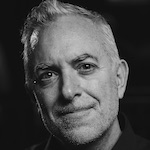
Dr Ajit Menon is a business psychologist and consultant with many years of experience consulting to organisations of all sizes and complexities. Ajit specialises in working with culture and change in organisations. He is the co-founder of Blacklight Advisory Ltd, a specialist organisational consultancy, and has been visiting faculty at the London School of Economics and the Tavistock and Portman.

Trevor Hough is a clinical psychologist, executive coach, and organisation development consultant. Trevor has a strong interest in working with impact investment portfolio companies in Asia and Africa. He has been consulting to a diverse range of organisations globally for the last 15 years
Their debut book, What Lies Beneath: How Organisations REALLY Work, is a fascinating insight into the hidden aspects of organisations.
It’s a cold and grey Saturday morning in London and I (Ajit) am staring at Trevor via zoom in his warm game lodge in the South African Bush with envy. We have just spent the week dealing with an issue with one of our clients where there is a conflict in their top team. We have just finished arguing with each other and taking different positions to test out our hypotheses on what could be going on in this client system. We are both tired, enraged but passionate about finding a solution. This is how we work best, when we take a critical view of our work and truly interrogate what’s going on below the surface.
We have both worked as consultants for most of our careers. During this time, we have consulted to organisations of various sizes and complexities. These organisations have ranged from large financial services firms, government bodies, game reserves, diamond mines, state and private hospitals, to name a few. Needless to say, these experiences have contributed to our understanding of organisations, systems, societies and the people within them. Having both been trained psychologically and psychoanalytically, we naturally take a ‘different’ view to consulting in organisations. We are steadfast in our pursuit of what cannot be accessed, cannot be seen and is not tangible, which we believe are some of the critical factors that impede organisational performance.
 We have both been both consultants to these businesses and consumers of consultancy services. Our experiences from both positions have taught us that this work is too often shrouded in mystery and rhetoric. Consultants often get a bad name, with leaders saying to us that ‘consultants only tell us what we know but follow it up with a large bill’. Also, we have witnessed many consultants who have hidden behind their theoretical dogma, making it difficult for clients to really understand what is going on in their organisations and in the consulting process.
We have both been both consultants to these businesses and consumers of consultancy services. Our experiences from both positions have taught us that this work is too often shrouded in mystery and rhetoric. Consultants often get a bad name, with leaders saying to us that ‘consultants only tell us what we know but follow it up with a large bill’. Also, we have witnessed many consultants who have hidden behind their theoretical dogma, making it difficult for clients to really understand what is going on in their organisations and in the consulting process.
In this book, through 8 stories (composites) from our practice, we attempt to paint the picture of what goes on in a consulting encounter. With an incisive foreword by Vega Roberts who talks about the need to delve beneath the surface in organisations, these stories are written from the perspective of one of the consultants. It gives the reader a glimpse into the mind of the consultant and is aimed both at other consultants and at consumers of consultancy services. These stories are not intended to be case studies but, instead, a voyeuristic lens into the work. And they humanise the process rather than intellectualising it.
A very important element of this book is the idea of supervision. We have taken peer supervision, or what the Grubb Institute calls ‘extravision’, as our model, whereby we make our consulting stories available to scrutiny from each other. For both of us, this has been a fantastic learning process as it evokes different emotions, reactions, and feelings than being supervised by someone who is more senior in the field. At the end of each chapter, you will find a brutally honest discussion between the two of us in the spirit of extravision, where we deconstruct the story and look to understand what is going on below the surface. Through this we are trying to demystify what happens in supervision or extravision.
As Vega says in her foreword:
“There are different ways to come along on these intriguing journeys. You can come as a passenger, reading the book as a kind of travelogue, finding resonances with experiences you have had yourself. Or you can choose to alight from time to time to consider your own moments of perplexity and derailment in more depth, using your emotional experiences to ‘consult to yourself’. And when you have gone as far as you can on your own, you might want to think who could accompany you in diving deeper to help you uncover what lies beneath.”
Ajit Menon and Trevor Hough
